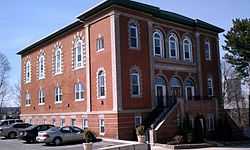Temple Emanuel Sinai (Worcester, Massachusetts)
| Temple Emanuel Sinai עמנואל סיני | |
|---|---|
 | |
| Basic information | |
| Location |
280 May Street 661 Salisbury Street Worcester, Massachusetts, U.S. |
| Geographic coordinates | 42°16′00″N 71°50′23″W / 42.266802°N 71.839798°WCoordinates: 42°16′00″N 71°50′23″W / 42.266802°N 71.839798°W |
| Affiliation | Reform Judaism |
| Status | Active |
| Leadership | Cantor Kim Singer |
| Website | www.emanuelsinai.org |
Temple Emanuel Sinai (Hebrew: עִמָנוּאֵל סִינַי, God is with us Sinai) is a medium-sized Reform (progressive) Jewish synagogue located in Worcester, Massachusetts, New England's second largest city (population 181,045).
A product of the 2013 integration of Worcester's two original Reform synagogues (Temple Emanuel and Temple Sinai), the Temple traces its roots to 1921 and is affiliated with the Union for Reform Judaism (URJ), a network of over 900 progressive synagogues representing the largest denomination (38%) of affiliated American Jews.
The Temple operates out of both of the original congregations' buildings in Worcester (280 May Street and 661 Salisbury Street), though Temple Emanuel's May Street campus was sold to the Worcester State University Foundation in 2013. The terms of the sale allow the congregation to use the building for two years, until June 2015. Planning to determine a final siting for the synagogue concluded during the fall of 2014, resulting in a plan to expand and renovate the Temple Sinai facility at 661 Salisbury Street (rather than share a campus with Conservative Congregation Beth Israel at Beth Israel's location on Jamesbury Drive).[1]
Temple Emanuel Sinai's first rabbi, Matthew Berger, also served as the last rabbi of Temple Emanuel, who hired him in 2009. In February 2014, Rabbi Valerie Cohen, spiritual leader since 2003 at Jackson, Mississippi's Beth Israel Congregation accepted an offer to replace Berger at the end of his contract in June 2014.[2] A vote to ratify her contract was held during a special congregational meeting at the May Street campus on March 9, 2014. The vote was near-unanimous in favor of hiring Rabbi Cohen.
Temple Emanuel
Founded in 1921, Emanuel was the first of two Reform congregations founded in Worcester and was the largest synagogue (of any kind) in the city from the 1940s until 2013 when it integrated with its own offshoot, Temple Sinai. The congregation's third and most majestic home was constructed and consecrated in 1949 and greatly expanded in 1961 to accommodate a burgeoning religious school enrollment of nearly 1,000 students.[3] Membership peaked at 1,340 families in 1957, making it one of the largest Reform congregations in the country at the time.[4] As late as 1982, Temple Emanuel was still the second-largest Reform congregation in New England.[5] As of 2009, membership was at 425 families.[6]
Notably, Temple Emanuel had two long-tenured rabbis who were influential in the larger Worcester community, and in the Reform movement. Levi Olan (1929–1948) became the first Jewish president of the Worcester Ministerial Union and grew Temple membership from less than 200 families to 610 families during his tenure. Joseph Klein (1949–1996) continued Olan's tradition of interfaith leadership and also served as president of the Worcester Ministers' Association and the Greater Worcester Clergy Association. Membership grew during his tenure from 610 families to 1,340 families in 1957, before seeing a gradual decline.[7]
Temple Sinai
In a letter dated December 16, 1957, the "Steering Committee of Temple Sinai," a small group of Temple Emanuel members who felt that the close family atmosphere of the Temple had been lost and that religious observance had become more conservative over the years, informed the secretary of the board of Temple Emanuel that they intended to create a second Reform congregation in Worcester. Temple Sinai's Statement of Principles indicated it would limit membership to 500 families.[7]
Integration
Due to declining membership and increasing financial hardship resulting from demographic changes in Worcester's Jewish community, Temple Emanuel and Temple Sinai members engaged in re-integration discussions on December 9, 2011, when after 54 years of separation and at least 20 years of coaxing from the URJ, Temple Sinai leadership officially contacted Temple Emanuel to pursue it.[8]
Temple Emanuel's leadership began to pursue opportunities to sell its May Street complex in 2012 when integration discussions with Temple Sinai concluded that Sinai's campus at 661 Salisbury Street was an ideal location for the new congregation. At a congregational meeting on May 30, 2013, the sale of the building at 280 May Street to the Worcester State University Foundation was approved by Temple Emanuel membership.[9] The proposed re-integration with Temple Sinai was approved by the members of both congregations in June 2013. Both congregations had already voted to name the new entity "Temple Emanuel Sinai."
Rabbinical leadership
| Name | Years |
|---|---|
| Matthew Berger | 2013–2014 |
| Valerie Cohen | 2014– |
- Matthew Berger served as Rabbi of Temple Emanuel from 2009 to 2013.
Cantorial leadership
| Name | Years |
|---|---|
| Kim Singer | 2013– |
- Kim Singer served as Cantor of Temple Sinai from 2008 to 2013.
Temple Emanuel History
Early history (1920-1948)
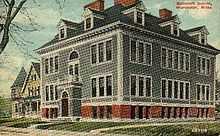
On June 29, 1920, sixty men whose families had moved from the Jewish enclave of Union Hill on Worcester's working class East Side to the more fashionable West Side met at the Bancroft Hotel in downtown Worcester to discuss plans to raise funds for the establishment of a synagogue on the West Side. In 1921, they began holding services (in a Modern Orthodox style) above Easton's tea room at Harrington Corner in downtown Worcester.[10] In 1921, the group officially incorporated as the "Worcester Modern Congregation" and in 1922 opened its first synagogue in a home at 22 Suburban Road in Worcester, calling it the "West Side Community House."[11] By 1923, the congregation had outgrown its facility and moved into the former Bancroft School building at 111 Elm Street, naming it Temple Emanuel.[12] The congregation gradually adopted Reform practices and affiliated officially with the national movement, under the leadership of Rabbi Levi Olan, in 1937. In 1949, the congregation moved to its final home at the junction of May and Chandler Streets.[7]
Joseph Klein era (1949-1977)
The Temple's longest-serving rabbi, Joseph Klein, began his duties on January 1, 1949, retired in 1977, and would remain on the pulpit as Rabbi Emeritus until his death in 1996. Klein is famously credited with inspiring at least eight young congregants at Temple Emanuel to attend Hebrew Union College, the Union for Reform Judaism's Rabbinical seminary,[13] including the immediate past President of the Union for Reform Judaism, Rabbi Eric Yoffie.
Rabbi Klein also mentored Yoffie's predecessor, Rabbi Alexander M. Schindler who was hired in 1953 as Temple Emanuel's first Assistant Rabbi. Schindler served as Assistant Rabbi from 1953 to 1955 and as Associate Rabbi from 1955 to 1959 when he left the congregation to become Executive Director of the New England Region of the what was then known as the UAHC. Rabbi Schindler was elected president of the UAHC in 1973, serving as the leader of North America's Reform Jews until 1996.[7]
In 1957, Temple Emanuel's membership peaked at 1,340 member families (including 42 families who were also members of the Conservative Congregation Beth Israel). Worcester's ten other Jewish congregations, including Shaarai Torah, had a combined family membership of 1,410.[4]
In his retirement, Klein went on to serve (part-time) as the first Rabbi of Temple Beth-El in Las Cruces, New Mexico until 1984 when he and his wife Rose returned to Worcester.[14] He then served, actively, as Rabbi Emeritus of Temple Emanuel until his death at the age of 84 on Sunday September 29, 1996.[15] Also of note, Klein was the great-grandfather of Hollywood actress Alisan Porter, who starred in Curly Sue.[16]
Significant events
From 1959 to 1962, Temple Emanuel hosted a series of lectures called Temple Forum which saw Hubert Humphrey (1959), Martin Luther King, Jr. (March 12, 1961), Theodore Bikel (1962), and Eleanor Roosevelt (1962) all speak to the congregation.[17][18]
In 1965, Herbie Hancock and other jazz legends accompanied 17 year-old congregant and conductor Jonathan Klein to record "Hear O Israel: A Prayer Ceremony in Jazz" in front of a crowd of 1,000 people inside the Temple.[19]
Temple Emanuel was the site, on August 25, 1967, of the funeral for Dr. Gregory C. Pincus, an American biologist and researcher who co-invented the birth-control pill.[20]
Post-Klein era (1977-2013)
In 1977, Temple Emanuel elected Rabbi Stanley Davids to succeed Rabbi Klein as its 5th spiritual leader. Rabbi Davids introduced the Temple's Chavurah program and brought the Gates of Prayer - New Union Prayerbook to the congregation. Rabbi Davids left in 1986 to become Rabbi of Central Synagogue in New York City.[7]
On April 19, 1989, the funeral for Abbie Hoffman, the famous 1960's radical, founder of the Yippies and member of the Chicago Seven who had died at the age of 52 one week earlier, was held in Temple Emanuel's Persky sanctuary. Over 900 people were in attendance and an overflow crowd of hundreds more listened outside the temple over a loudspeaker. In attendance were basketball star Bill Walton, folk singer Pete Seeger, movie producer Bert Schneider,[21] fellow Yippie Aron Kay, Republican political consultant Jay Severin,[22] Hoffman's cousin and Pulitzer Prize-winning journalist Sydney Schanberg, and Jerry Rubin, fellow Chicago Seven member.[23]
Temple Emanuel celebrated its 70th anniversary on October 25, 1991 by honoring four people who had made significant impacts on the congregation. Then-Vice President of the Union for Reform Judaism Rabbi Eric Yoffie, who grew up in the congregation, gave the sermon. Rabbi Emeritus Joseph Klein and past presidents Milton S. Sheftel, Judith S. Yoffie and Wallace W. Wolf (posthumously) were honored.[24]
On June 12, 2003, the congregation officially installed Carlton Watson, a black man who had converted to Judaism, as its president. Watson, executive director of the Henry Lee Willis Community Center in Worcester, is believed to be the first black person to serve as president of a synagogue in the United States.[25][26]
Longmeadow native Rabbi Matthew L. Berger served as Temple Emanuel's ninth and last spiritual leader from July 2009 through June 2013. Berger served as the rabbi of Temple Emanuel Sinai for its first year of existence (June 2013 through June 2014) until he was replaced by Rabbi Valerie Cohen.[27]
Education
Historically, Temple Emanuel's renowned Religious School met three days per week during the school year (Monday and Wednesday afternoons for Hebrew and Saturday mornings to study Torah, liturgy, Israel and Jewish culture) in the Temple's three-story classroom wing. In the mid-2000s the schedule was reduced to just Wednesday afternoons and Saturday mornings. The school worshipped together at the conclusion of classes every Saturday in the Temple's Stacey A. Cohan youth center.
In 2012, Temple Emanuel joined Congregation Beth Israel and Temple Sinai in creating PaRDes - The Worcester Jewish Community Religious School, under the auspices of the Jewish Federation of Central Massachusetts. The school's roughly 130 students attend Monday and Wednesday afternoon classes at Beth Israel and Saturday mornings at Temple Emanuel Sinai.
Facilities
Temple Emanuel's home from 1949 to 2013, designed by Boston architect Charles R. Greco, is located at the junction of May and Chandler Streets in the heart of Worcester's leafy, residential West Side, adjacent to Worcester State University. The original structure, built in brick and designed in the Colonial Revival style, was consecrated in 1949. A 1,000-seat auditorium, a second classroom wing, and a suite of clergy offices were added in 1961.
The Temple's two-story 1961 classroom wing was leased to a series of educational institutions once religious school enrollment began to decline in the 1970s, including Worcester State University, the Abby Kelley Foster Charter Public School, Y.O.U., Inc.'s Kathleen Burns Preparatory School, and Quinsigamond Community College's Training and Education center.[28]
Dedicated spaces
- Abraham & Mae Persky Sanctuary (626 seats)
- Philip & Mary Rose Chapel (174 seats)
- Stacy A. Cohan Youth Center
- Joseph and Sophie Cohan Nursery School Playground
In 2011, the Persky sanctuary underwent its only major renovation. The first 6 rows of pews were removed to make room for an extended, lower bimah (speaker's platform) that was intended to create a more intimate atmosphere and enable the congregation to use the space more frequently. This reduced the capacity of the sanctuary from 918 to 626.[29]
Parsonage
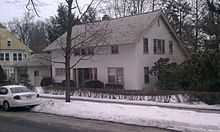
Temple Emanuel did not own a parsonage, but Rabbis Olan and Klein both resided at 5 Montvale Road in Worcester's exclusive Montvale Historic District.
Worship
Daily Minyan
Temple Emanuel was unique among American Reform synagogues in that for most of its history, it offered its members and the Worcester Jewish community the opportunity to attend a worship service seven days per week. In addition to clergy-led Shabbat services every Friday evening and Saturday morning, the congregation had a regular lay-led weekday minyan, which was held five days every week (Sunday through Thursday) from 1954 until 2011 when the 9:30 AM Sunday Shacharit (morning prayers) service was discontinued due to low attendance.
The "Daily Minyan" was originally instituted by Rabbi Klein on January 4, 1954, though it was led exclusively by lay leaders of the congregation.[7] Temple Emanuel Sinai has continued the tradition of holding weekday services, though Mincha (afternoon prayers) and Maariv (evening prayers) are only read in the Salisbury Street sanctuary on Mondays at 5:45 PM. (The Tuesday evening service was discontinued by Temple Emanuel in 2012 and Wednesday and Thursday evening services were discontinued by Emanuel Sinai in early 2014.)
Shabbat
Regular Shabbat services are typically held Friday evenings at 7:00 and Saturday mornings at 10:30.
Photo gallery
-
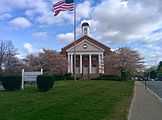
Cherry Blossoms at 280 May Street
-

Philip & Mary Rose Chapel at 280 May Street
-
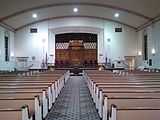
Abraham & Mae Persky Sanctuary at 280 May Street
-

Abraham & Mae Persky Sanctuary at 280 May Street
-
May Street façade with chapel and auditorium entrances
-
Auditorium Complex
-
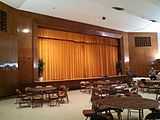
Auditorium at 280 May Street
-
Chandler Street Entrance and Religious School wing
-
Bet Shalom Apartments (Worcester Jewish Community Housing For The Elderly, Inc.)
Temple Emanuel Rabbinical leadership
| Name | Years | Emeritus |
|---|---|---|
| Maurice Mazure | 1923–1926 | |
| Julius Gordon | 1926–1929 | |
| Levi Olan | 1929–1948 | |
| Joseph Klein | 1949–1977 | 1977–1996 |
| Stanley Davids | 1977–1986 | |
| Norman Mendel | 1986–1991 | |
| Stuart Gershon (interim) | 1991–1992 | |
| James Simon | 1992–1998 | |
| Sigma Faye Coran (interim) | 1998–1999 | |
| Jordan Millstein | 1999–2008 | |
| Ilene Bogosian (interim) | 2008–2009 | |
| Matthew Berger | 2009–2013 |
Temple Emanuel Assistant/Associate rabbis
| Name | Years | Later Position |
|---|---|---|
| Alexander Schindler | 1953–1959 | President of the Union for Reform Judaism 1973-96 |
| Daniel L. Kaplan | 1959–1962 | Senior Rabbi at Temple Beth Shalom, Needham, MA 1962-70 |
| Leivy Smolar | 1962–1965 | President of Baltimore Hebrew University 1971-92[30] |
| David Davis | 1965–1967 | Rabbi Laureate at Congregation Ohabai Sholom (Nashville, Tennessee) |
| Henry A. Zoob | 1967–1970 | Rabbi Emeritus at Temple Beth David, Westwood, MA |
| Ira S. Youdovin | 1970–1973 | Executive Vice President of the Chicago Board of Rabbis |
| Harold S. Jaye | 1973–1974 | Rabbi at Temple B'Nai Darom, Ocala, FL 1987–Present |
| Peter Tarlow | 1974–1977 | Hillel Director, Texas A&M |
| David Sofian | 1977–1980 | Senior Rabbi at Temple Israel (Dayton, Ohio) |
| Steven Fox | 1980–1982 | Executive Vice-President, CCAR |
| Daniel L. Pernick | 1982–1985 | Senior Rabbi at Beth Am Temple, Pearl River, NY |
| Alan M. Ullman | 1985–1988 | Founder of the School for Jewish Studies |
| Janice Garfunkel | 1988–1989 | Rabbi at Temple Sholom (Springfield, Ohio) 2004-10[31] |
| Stuart Weinberg Gershon | 1989–1994 | Rabbi at Temple Sinai, Summit, NJ |
| Sigma Faye Coran | 1994–1999 | Senior Rabbi at K.K. Bene Israel / Rockdale Temple, Cincinnati, OH |
- Stuart Weinberg Gershon served as Interim Senior Rabbi from 1991-1992.
- Sigma Faye Coran served as Interim Senior Rabbi from 1998-1999.
Temple Emanuel Auxiliary rabbis
Due to a decline in membership, Temple Emanuel's full-time assistant rabbi position was eliminated in June 1998. From that time through June 2009, the Temple was served by one full-time Rabbi with the assistance of a part-time Auxiliary Rabbi (or, from 2002–2004, a full-time cantor). From 2009 to 2013, all pastoral duties were performed by the Rabbi.
| Name | Years | Later Position |
|---|---|---|
| Howard A. Berman | 1998–1999 | Founding Rabbi of Central Reform Temple, formerly known as Boston Jewish Spirit |
| Paula L. Feldstein | 1999–2002 | Shalom Baby Coordinator, Synagogue Leadership Initiative, UJA Federation of Northern New Jersey |
| Dennis Ross | 2004–2009 | Author; Director of Concerned Clergy for Choice |
- From 2002-2004, Cantor Sally Neff assisted in performance of pastoral duties.
Temple Emanuel Cantorial leadership
| Name | Years |
|---|---|
| Hugo Chaim Adler | 1939–1955[32] |
| Joseph Gottlieb | 1955–1978[33] |
| Howard Tabaknek | 1978–1982 |
| Sheri Blum | 1982–1994[34] |
| Betsey Peters-Epstein | 1994–2002 |
| Sally Neff | 2002–2004 |
| Daniel Mutlu | 2004–2008 |
| Sharon Brown Goldstein | 2009–2013 |
Temple Sinai History


Temple Sinai held services for its first 5 years (1957 to 1962) at the Worcester Jewish Community Center, which had moved in 1951 to Temple Emanuel's old building at 111 Elm Street. In 1962, Sinai moved to a 42-acre estate the congregation had purchased at 661 Salisbury Street, holding services and religious school in a large mansion.[35] In 1980, the congregation opened its first purpose-built synagogue on the site, keeping the mansion intact for offices and religious school use. The Jewish Community Center, also outgrowing the facility on Elm Street, built on land next door at 633 Salisbury Street and moved in 1967.[36]
Temple Sinai at first embraced many of the customs of "Classical" Reform Judaism that Temple Emanuel did not practice. For example, Sinai members shed traditional religious garments like Kippot (skullcaps) and Tallitot (prayer shawls), though those customs returned over the years.[37]
The congregation hired its first rabbi, Leonard Helman, previously an assistant rabbi at what was then known as Temple Beth Israel in West Hartford, Connecticut, in 1958.[38] He was succeeded by Rabbis John Rosenblatt and Michael Berenbaum. David Kaplan served as Cantorial soloist in its early days. Rabbi Gary Glickstein followed as rabbi from 1977 to 1985 and was succeeded by Rabbi Seth Bernstein, Temple Sinai's longest tenured spiritual leader, from 1986 to 2011.[39] Cantor Wendy Autenrieth served the congregation as Cantor/Educator from 1987 to 1999.[40]
Temple Sinai Rabbinical leadership
| Name | Years | Emeritus |
|---|---|---|
| Leonard Helman | 1958–1959 | |
| Kenneth Stein | 1959-1967 | |
| Joseph Kursak | 1967-1970 | |
| John Rosenblatt | 1970-1971 | |
| Sanford Seltzer (Interim) | 1971-1973 | |
| Harold Jaye (Interim) | 1971-1973 | |
| Michael Berenbaum | 1973–1976 | |
| Sanford Seltzer (Interim) | 1977 | |
| Gary Glickstein | 1977–1985 | |
| Seth Bernstein | 1986–2011 | 2011–2013 |
| Scott Saulson (interim) | 2011–2012 | |
| Michael Swartz (interim) | 2012–2013 | |
| Carol Glass (interim) | 2012–2013 |
Temple Sinai Cantorial leadership
| Name | Years |
|---|---|
| David Kaplan | 1957–1977 |
| Harriett Katz | 1977–1987 |
| Wendy Autenrieth | 1987–1999 |
| Claire Metzger | 1999–2006 |
| Robin Sparr-Rothman | 2006–2008 |
| Kim Singer | 2008–2013 |
Prominent alumni
Rabbis
| Name | Later Position |
|---|---|
| Andrew Baker | Director of International Jewish Affairs, American Jewish Committee |
| Arthur Bielfeld[41] | Rabbi at Temple Emanu-El, North York, ON, Canada, 1968–2001 |
| Lewis E. Bogage[42] | Associate Rabbi at Central Synagogue, New York City |
| Kenneth Brickman | Rabbi at Temple Beth-El, Jersey City, NJ, 1989–2011[43] |
| Marc S. Dworkin | Executive Director, American Jewish Committee, Orange County |
| Daniel Freelander | Senior Vice President of the Union for Reform Judaism, member of Kol B'Seder |
| Paul J. Kipnes | Rabbi at Congregation Or Ami, Calabasas, CA |
| Steven S. Mason | Senior Rabbi at North Shore Congregation Israel, Glencoe, IL, 1997–current |
| Jill Starkweather Perlman | Assistant Rabbi at Temple Isaiah, Lexington, MA, 2011-present |
| Dennis Shulman | Democratic nominee for the United States Congress in New Jersey's Fifth Congressional District, 2008[44] |
| Karen Thomashow | Associate Rabbi at Isaac M. Wise Temple, Cincinnati, OH, 2013-current |
| Eric Yoffie | President of the Union for Reform Judaism, 1996–2012[45] |
| Jonah Zinn | Assistant Rabbi at Congregation Shaare Emeth, St. Louis, MO, 2014-current |
Cantors
| Name | Later Position |
|---|---|
| Michael M. Mandel | Cantor, Congregation Beth Emeth, Wilmington, DE, 2001-2003[46][47] |
- Alan F. Segal, Professor of Religion and Ingeborg Rennert Professor of Jewish Studies at Barnard College[48]
- Paul D. Eisenberg, Professor Emeritus of Philosophy at Indiana University[49]
- Jay Gordon, Host of Elvis Only on WODS, Oldies 103.3 FM (Boston, MA)
- Jeffrey Hodes, Co-Executive Producer, 3rd Rock from the Sun (2000-2001)[50]
Prominent members
- Samuel Adler, Composer
- Massachusetts State Senator Harriette L. Chandler (Democrat, First Worcester District)
- Arthur E. Chase, Former Massachusetts State Senator (Republican)
- Joseph C. Casdin (died 2007 age 93) Mayor of Worcester 1959, 62-63, 67-68
- Harold Devine (died 1998 age 88), 1928 Olympic Bronze Medal Recipient in Boxing [51]
- Joanne Goldstein, Secretary of Labor and Workforce Development, Commonwealth of Massachusetts 2010–Present[52][53]
- Jacob Hiatt, businessman and philanthropist.[54]
- Abbie Hoffman,[23][55] 1960's radical and founder of the Yippies
- Myra Kraft, late wife of Robert Kraft, owner of the New England Patriots
- Harry C. Payne, President of Williams College 1994-1999[56][57]
- Denise Eisenberg Rich, songwriter, socialite, philanthropist, and political fundraiser, ex-wife of Marc Rich
- Warren M. Robbins, Founder of the National Museum of African Art[58]
- David B. Yoffie, Director of Intel Corporation[59]
Worcester West Side Synagogue history
Worcester has five operating synagogues, with two other organizations holding regular Jewish worship services in the city.
| Name | Current/Last Address | Denomination | Years Open |
|---|---|---|---|
| Temple Emanuel | 280 May Street | Reform (URJ) | 1921–2013 |
| Temple Sinai | 661 Salisbury Street | Reform (URJ) | 1957–2013 |
| Temple Emanuel Sinai | 280 May Street & 661 Salisbury Street | Reform (URJ) | 2013– |
| Congregation Beth Israel | 15 Jamesbury Drive | Conservative (USCJ) | 1924– |
| Congregation Shaarai Torah - Sons of Abraham West | 835 Pleasant Street | Orthodox (OU) | 1959– |
| Congregation Beth Judah | 889 Pleasant Street | Orthodox (Young Israel) | 1942– |
| Congregation Tifereth Israel - Sons of Jacob | 22 Newton Avenue | Orthodox (Chabad) | 1959– |
Other assemblies
- Clark University Hillel
- Jewish Healthcare Center chapel ("Congregation Mogen David")
Photo gallery
-
Congregation Beth Judah
-
Congregation Tifereth Israel - Sons of Jacob shul and Yeshiva Achei Tmimim Academy
-
_Chapel.jpg)
Jewish Healthcare Center chapel
Worcester East Side Synagogue history
Before the Jewish population of Worcester shifted from Union Hill to the West Side, the community had established 12 Orthodox synagogues on the East Side.
| Hebrew Name | Transliteration | English Translation | Address(es) | Years Open | Notes[60] |
|---|---|---|---|---|---|
| בני ישראל | B'nai Yisrael | Sons of Israel | 79 Green Street, 24 Providence Street | 1875-1957 | Torn down for construction of I-290 in 1957 |
| בני אברהם | B'nai Avraham | Sons of Abraham | 10 Plymouth Street (1888-1913), 23 Coral Street | 1886-1948[61] | Merged with Shaarai Torah in 1948 |
| שערי צדק | Shaarei Tzedek | Gates of Righteousness | 8 Beach Street, 16 Gold Street, 3 Summit Street | 1892-? | also known as Tower of Truth |
| אגודת אחים | Agudas Achim | Union of Brothers | 19 Brown Street, 9 Pond Street | 189?-? | also known as Good Brothers |
| (צמח צדק (אנשי סמוליאן | Tzemach Tzedek (Anshe Smolian) | Plant of Justice (People of Smolyan) | 10 Plymouth Street | 1900-1923 | Changed name to Sons of Jacob in 1923 |
| שערי תורה | Shaarai Torah | Gates of Learning | 32 Providence Street | 1904-1999 | |
| (אגודת ישראל (אנשי ספרד | Agudas Israel (Anshe Safard) | Union of Israel (Sephardic) | 66 Harrison Street | 1913-196? | |
| בני יעקב | B'nai Yaakov | Sons of Jacob | 104 Harrison Street | 1923-1965 | Merged with Tifereth Israel (West Side) in 1965 |
| תפארת ישראל | Tifereth Israel | Pride of Israel | 42 Harrison Street | 19??-1957 | Torn down for construction of I-290 in 1957 |
| בני ציון | B'nai Tzion | Sons of Zion | |||
| קדימה | Kadimah | Forward | |||
| אנשי ראקישוק | Anshe Rakishok | People of Rokiškis | |||
Photo gallery
-
Sons of Abraham
References
- ↑ Temple Emanuel Sinai Community News, Vol. 2 No. 2, October 2014.
- ↑ Anonymous. "Rabbi Cohen leaving Jackson's Beth Israel, "J.C." leaving Jacobs Camp" Southern Jewish Life. Feb 24 2014.
- ↑ Worcester, Jewish Virtual Library website. Retrieved January 4, 2010.
- ↑ 4.0 4.1 "The Jews of Worcester: A Population Study" PDF (582 KB), Worcester Jewish Federation, 1958, p. 11.
- ↑ Anonymous. "Nov. 21 concert at Beth Am Temple honors rabbi" NorthJersey.com Nov 17 2010.
- ↑ Kush, Bronislaus. "Ready for challenges: Worcester Temple has faith it will survive" Worcester Telegram & Gazette. Sep 26 2009.
- ↑ 7.0 7.1 7.2 7.3 7.4 7.5 Feingold, Norma and Sadick, Nancy. Temple Emanuel 1921-1996 75th Anniversary. Published by Temple Emanuel, 280 May Street, Worcester, Mass. 1996.
- ↑ Kush, Bronislaus B. "2 Jewish temples consider merger" Worcester Telegram & Gazette. May 11, 2013.
- ↑ Eckelbecker, Lisa. "Members OK Sale of Temple Emanuel to WSU Foundation" Worcester Telegram & Gazette. Jun 01 2013.
- ↑ Shaw, Kathleen A. "WSC may Buy Temple." Telegram & Gazette: B.3. Telegram & Gazette (Worcester). Mar 24 1993.
- ↑ Olitzky, Kerry M.; Raphael, Marc Lee. The American Synagogue: A Historical Dictionary and Sourcebook, Greenwood Press, June 30, 1996, pp. 173–175.
- ↑ Temple Emanuel - Worcester, MA - History
- ↑ Aron Hirt-Manheimer. Rabbi Eric H. Yoffie: Teacher of Living Torah. Reform Judaism magazine. (Fall 1996)
- ↑ Temple Beth-El History
- ↑ "Rabbi Joseph Klein, 84; leader in Reform Judaism, served Temple Emanuel :[ALL Edition]. " Telegram & Gazette 30 Sep. 1996,Massachusetts Newsstand, ProQuest. Web. 12 Oct. 2009.
- ↑ Richard Duckett. "Following in mother's dance-steps ; Worcester native Alisan Porter scores with Chorus Line' :[ALL Edition]. " Telegram & Gazette 8 Jun 2006.
- ↑ Temple Emanuel (Worcester, Mass.)., et al. Forum Series Lectures. [audiorecording] 1959-1962. American Jewish Archives.
- ↑ "A dream alive ; Nation continues to pursue King's legacy :[ALL Edition]. " Telegram & Gazette 15 Jan. 2007
- ↑ Gray, L.. (2008, October). Hear, O Israel: A Prayer Ceremony in Jazz [review of the CD Hear O Israel: A Prayer Ceremony in Jazz]. New Internationalist,(416), 30-31. Retrieved April 16, 2010, from CBCA Complete. (Document ID: 1591114401).
- ↑ "Dr. Pincus, Developer of Birth Control Pill, Dead; Funeral Services to Be Held Friday." Jewish Telegraphic Agency 24 Aug 1967.
- ↑ Anonymous, Associated Press. (2011, December 14). 'New Hollywood' producer Bert Schneider dies.
- ↑ Philip Lentz, Chicago Tribune. (1989, April 20). `Abbie's free,' and pals say goodbye :[NORTH SPORTS FINAL, C Edition]. p. 3.
- ↑ 23.0 23.1 Judith Gaines, Globe Staff. 1989. FRIENDS RECALL ABBIE HOFFMAN'S RADICAL WIT :[THIRD Edition]. Boston Globe, April 20.
- ↑ Kathleen A. Shaw. (1991, October 25). Temple Emanuel to mark 70 years :[FINAL Edition]. Telegram & Gazette,p. A2.
- ↑ Mark Melady. "Adopted faith is put into service; Watson becomes temple president:[FINAL Edition]. " Telegram & Gazette 13 Jun 2003.
- ↑ Carlton Watson. "The Dream." Reform Judaism Magazine Vol. 32 No. 3 Spring 2004 Edition 12 Jul 2004.
- ↑ http://www.temple-emanuel.org
- ↑ Pilon, Matt. "QCC Seeks Downtown Expansion." Worcester Business Journal (wbjournal.com), Dec 16 2011.
- ↑ Temple Emanuel BY-Lines, Vol. LXXVI No. 5, June/July 2011.
- ↑ Brent Jones. "Leivy Smolar: [Age 69] The former president of Baltimore Hebrew University started the school's master's and doctoral programs. " Knight Ridder Tribune Business News 19 August 2007.
- ↑ Weiss, Marshall. "Former Temple Sholom rabbi dies." The Dayton Jewish Observer, 25 November 2013.
- ↑ Kathleen A. Shaw. "Decade is worth singing about :[ALL Edition]. " Telegram & Gazette 13 June 1992.
- ↑ "RELIGION DIGEST :[ALL Edition]. " Telegram & Gazette 26 September 1992.
- ↑ Lydia Okutoro. "Blum leaves Temple Emanuel ; Farewell concert is next Saturday :[ALL Edition]. " Telegram & Gazette 28 May 1994.
- ↑ Shapiro, Leo. "Local Lines: First Jewish Chaplain Commissioned in 1862." Boston Globe: 51. Sep 9 1962.
- ↑ http://www.worcesterjcc.org/about/history.html
- ↑ Shaw, Kathleen A. "Temple Tapestry a Long Labor of Love." Telegram & Gazette: A.1. May 08 1998.
- ↑ Anonymous. "Rabbi Helman Accepts Post In Bay State." The Hartford Courant: 30. May 15, 1958.
- ↑ Kush, Bronislaus B. "Rabbi Turns Focus to Family." Telegram & Gazette: B.3. Apr 12 2011.
- ↑ http://jewishcentralvoice.com/2012/02/the-integration-of-temples-emanuel-and-sinai/#comments
- ↑ Borenstein, Jack. "New member of Order of Canada rabbi emeritus of Temple Emanuel-El." Jewish Tribune (Toronto), September 11, 2012.
- ↑ Anonymous. "Obituaries; Mrs. Gertrude K. Bogage." The Bridgeport Post, February 17, 1969.
- ↑ http://www.betheljc.org/aboutus/history/
- ↑ Williamson, Dianne. "`Time to Take a Stand,' and Friends Join in." Telegram & Gazette: B.1. ProQuest. Dec 04 2007.
- ↑ Elaine Thompson, & Telegram & Gazette Staff. (1995, June 15). Rabbi gives credit to Worcester roots // Yoffie to head Jewish Reform group :[RT. 9 EAST, WACHUSETT, WORCESTER Edition]. Telegram & Gazette,p. B1.
- ↑ Daniela Herrera, 78. (1999, December 15). Telegram & Gazette,p. B9.
- ↑ Miller, Michelle Effron. "Rabbi Grumbacher Retires: A Look at His 37 Years at Wilmington's Congregation Beth Emeth" The Jewish Voice (Wilmington, DE) June 14, 2009.
- ↑ Hussain, Amir. "Alan Franklin Segal (1945–2011): In Memoriam." Journal of the American Academy of Religion Volume 79, Issue 4 Pp. 784-788 September 24, 2011.
- ↑ Paul D. Eisenberg - Borns Jewish Studies Program
- ↑ "Obituaries: Hodes, Jeffrey Brian." Los Angeles Times, Sep 22 2011.
- ↑ "Harold G. Devine, 88, Olympic boxing champ :[ALL Edition]." Telegram & Gazette, May 1, 1998
- ↑ Lee V. Gaines. (2011, May 30). Breaking through the barriers; Labor secretary has Worcester roots. Telegram & Gazette.
- ↑ "Adele Feinberg, 80 :[ALL Edition]. " Telegram & Gazette 12 Mar. 2002
- ↑ "In Memoriam: Jacob Hiatt". Holy Cross Magazine. Retrieved February 8, 2015.
- ↑ Jonah Raskin. For the Hell of It: The Life and Times of Abbie Hoffman. University of California Press, 1996.
- ↑ Gelbwasser, Michael. From Worcester to the top: Reform leader Rabbi Eric Yoffie credits success to Temple Emanuel upbringing. The Jewish Advocate (Boston, MA), May 1, 1997.
- ↑ Bryan Marquard. (2008, January 12). Harry C. Payne, at 60; led Williams College from '94-'99. Boston Globe,p. E.31.
- ↑ Clive McFarlane. (2008, December 12). African art visionary has a great legacy. Telegram & Gazette,B.1.
- ↑ Cohan, Peter. "Can Worcester power its startup magnet?" Telegram & Gazette: Oct 30 2011.
- ↑ http://www.jgsgb.org/pdfs/MassSynagogues.pdf
- ↑ "Former synagogue is now history :[ALL Edition]. " Telegram & Gazette 30 Dec. 1993.








